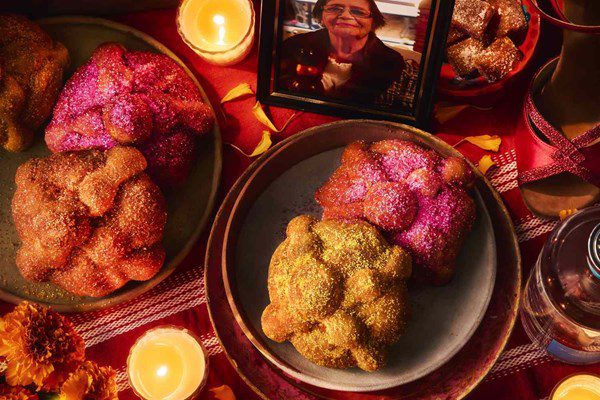The foods of Día de Muertos
October 30, 2024 by DarcieAfter tomorrow’s Halloween festivities, the Mexican celebration Día de Muertos or Day of the Dead follows, celebrated November 1-2 each year. Day of the Dead celebrations can be traced to the ancient Aztecs, who felt that instead of mourning the deceased, people should celebrate their lives and welcome their spirits back to the land of the living once a year. Common traditions for this holiday include creating altars to honor the dead, preparing offerings, sharing stories of the deceased, and decorating gravesites.

In pre-Columbian tradition, there are seven levels of the underworld or “Mictlan” that the soul must pass through before reaching the ninth level where the soul achieves eternal rest, so the celebrational altars of old usually consisted of seven levels. After the Spanish conquistadors brought Catholic missionaries who exerted their influence on the tradition, the altars were usually constructed with two or three levels representing heaven, earth, and purgatory. This resulting blending of cultures created the celebration known today. The holiday has spread from Mexico to the US and around the world.
The holiday is a festive day, with many colorful crafts on display. And like most celebrations, Día de Muertos has its own traditional foods like candied pumpkin, highly decorated sugar skulls, tamales, and pan de muerto or “bread of the dead.” Pan de muerto is a sweetened soft bread shaped into a boule and often decorated with bone-shaped pieces and frequently sprinkled with sugar or sesame seeds. Traditionally it is eaten at the altar (ofrenda) of the deceased, along with his or her favorite foods.
Categories
- All Posts (6940)
- Antipasto (2135)
- Author Articles (247)
- Book News (935)
- Cookbook Giveaways (983)
- Cookbook Lovers (257)
- Cooking Tips (109)
- Culinary News (299)
- Food Biz People (552)
- Food Online (791)
- Holidays & Celebrations (272)
- New Cookbooks (149)
- Recipes (1500)
- Shelf Life With Susie (231)
- What's New on EYB (133)
Archives
Latest Comments
- Atroyer7 on Danube Cookbook Review and Giveaway
- demomcook on What foods do you look forward to the most for each season?
- demomcook on Danube Cookbook Review and Giveaway
- Darcie on How cookbooks can help build resilience
- mholson3 on Danube Cookbook Review and Giveaway
- Rinshin on How cookbooks can help build resilience
- sarahawker on Danube Cookbook Review and Giveaway
- Sand9 on Danube Cookbook Review and Giveaway
- hankintoby29 on Heritage Cookies of the Mediterranean World – Cookbook Giveaway
- WBB613 on Feasts of Good Fortune Cookbook Giveaway